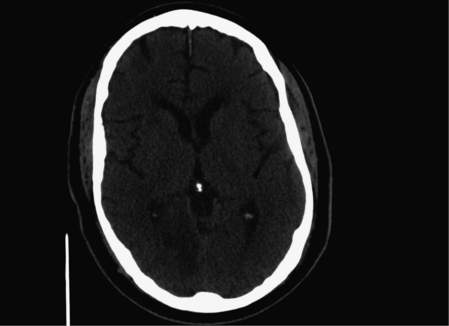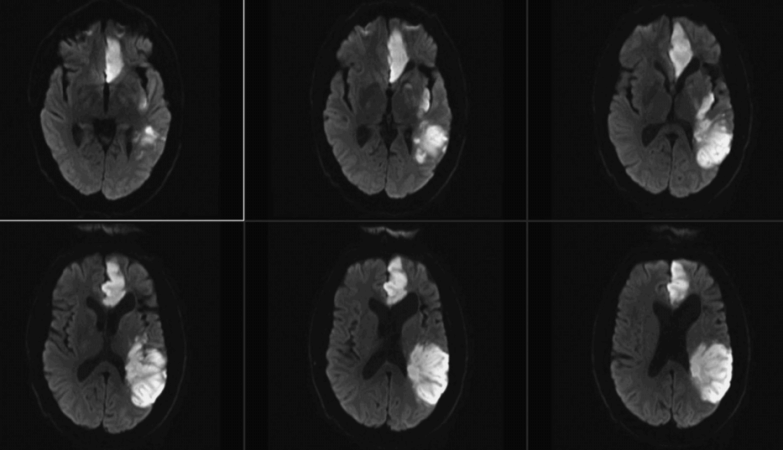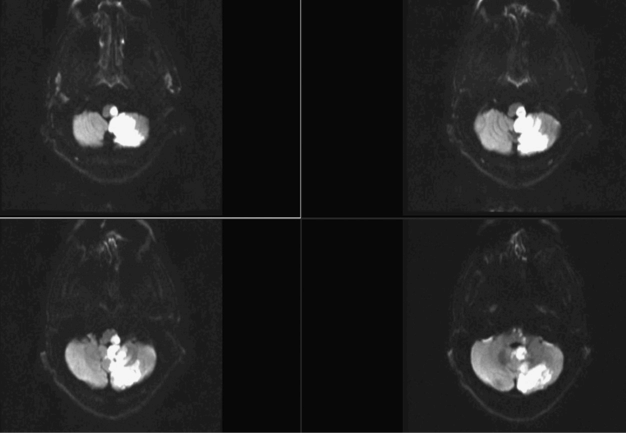Axial diffusion-weighted (right) and apparent diffusion coefficient (left) images show evidence of restricted diffusion in the right MCA distribution consistent with an acute cerebral infarction.
Discussion
Prosthetic heart valve replacement is performed annually in thousands of patients worldwide [1]. Management of patients with prosthetic heart valves requires lifelong anticoagulant therapy. Patients requiring prosthetic heart valve replacement are faced with a choice of a longer lasting mechanical heart valve that is associated with decreased quality of life due to coagulation monitoring and treatment-associated dietary restrictions, or a bioprosthetic heart valve that has a higher risk of failure and replacement surgery, but which is associated with improved quality of life.
Dabigatran etexilate (dabigatran) is an orally administered thrombin inhibitor used for the prevention of embolism and stroke in patients with non-valvular atrial fibrillation (NVAF). In the Randomized Evaluation of Long-Term Anticoagulation Therapy (RE-LY) study, dabigatran was shown to be effective in the treatment of patients with NVAF. The subsequent RE-ALIGN study failed to demonstrate the ability of dabigatran to prevent thromboembolic complications in patients with mechanical heart valves [1]. Patients in the RE-ALIGN study were randomized to receive either dabigatran or warfarin. The trial was terminated prematurely due to an excess of thromboembolic and bleeding events in patients treated with dabigatran. Dose adjustment or discontinuation was required in 52 of 162 dabigatran-treated patients (32%). Ischemic or unspecified stroke occurred in 5% (9/162) of patients treated with dabigatran and in none of those treated with warfarin. Major bleeding occurred in 4% (7/162) of patients treated with dabigatran, and in 2% (2/81) of patients treated with warfarin. Pericardial bleeding was found in all patients with major bleeding. Excessive bleeding with dabigatran occurred in patients started on treatment within 7 days of heart valve surgery and in patients who had had valve implantation for more than 3 months previously.
Patients with mechanical prosthetic heart valves have coagulation cascade and thrombin generation activated by the release of tissue factors from damaged tissues associated with valve placement. The artificial surface of the valve leaflets and sewing ring are also thrombogenic. Warfarin is thought to be more effective in these patients, as it has a broader effect on the coagulation system. Warfarin inhibits activation of tissue-induced coagulation (factor VII inhibition), contact-induced coagulation (inhibition of factor IX production), and common pathway factors (factor X and thrombin production). Dabigatran is effective in patients with NVAF where thrombus formation is believed to be triggered by blood stasis and endothelial dysfunction.
Tip
Warfarin is superior to dabigatran for stroke prevention in patients with prosthetic mechanical heart valves. Clinical trials of other novel oral anticoagulant agents (e.g., apixaban and rivaroxaban) in patients with AF excluded patients with prosthetic mechanical heart valves. Warfarin is the preferred anticoagulant agent for thromboembolic risk reduction in patients with prosthetic mechanical heart valve.
Case 2. Pitfalls in anticoagulation for stroke prevention in patients with low cardiac ejection fraction (EF) or severe cardiomyopathy
Case description
A 50-year-old man with history of coronary artery disease, non-ST elevation myocardial infarction (NSTEMI), ischemic cardiomyopathy, hypertension, and systolic chronic heart failure was admitted to hospital after sudden onset of word-finding difficulties, slurred speech, and right-sided weakness. MRI of the brain showed a cerebral infarction in the arterial distribution of the left anterior cerebral artery (ACA) and inferior division of the left MCA (Figure 5.2). Troponin levels were initially elevated. Transthoracic echocardiogram (TTE) and TEE reported a systolic ejection fraction (EF) of 20%. There were no intracavitary thrombi. He had no evidence of AF, and remained in sinus rhythm during his hospital stay. A 30-day event monitor recorded occasional premature ventricular complexes (PVCs). He was initially treated with warfarin, but approximately 6 months later he was switched to clopidogrel monotherapy. Follow-up TTE 6 months later showed persistent low EF (25%). He had no recurrent strokes or transient ischemic attacks (TIAs) while on warfarin or clopidogrel monotherapy.
Discussion
While the benefit of anticoagulation in patients with NVAF is robust and well established, its use in patients with normal sinus rhythm is controversial [2]. Individuals with a decreased EF <35% in sinus rhythm have an estimated 4% rate of embolic events, including stroke, pulmonary embolism, and peripheral artery embolization. Left ventricular thrombus (LVT) have been detected in 13%, and left atrial appendage (LAA) thrombus in 68% of these patients. These rates are decreased to 1.2% among patients treated with warfarin. Studies evaluating this benefit have not shown statistical significance by treatment type, including treatment with placebo. The modest benefit reported in the Warfarin and Antiplatelet Therapy in Heart Failure (WATCH) trial was associated with an increased risk of major hemorrhage [3].
The Warfarin versus Aspirin in Reduced Cardiac Ejection Fraction (WARCEF) trial evaluated patients with low cardiac EF and sinus rhythm [4]. No difference was noted in the rate of stroke, intracerebral hemorrhage or death between the two groups. Nevertheless, a subgroup analysis demonstrated a 48% relative risk reduction (RRR; P = 0.005) of ischemic stroke with warfarin use.
A further subgroup analysis defined ischemic stroke patients as definite, possible, or non-cardioembolic [4]. Warfarin treatment was associated with reduced rate of definite cardioembolic ischemic strokes compared to aspirin treatment (0.22 vs. 0.55 per 100 patient-years, P = 0.012), as well as a tendency for reduced rate of possible cardioembolic ischemic strokes (0.37 vs. 0.67 per 100 patient-years, P = 0.063). There was no difference in the rate of non-cardioembolic ischemic strokes by treatment.
Tip
Anticoagulation for recurrent stroke prevention in patients with EF <35% and sinus rhythm has not been established (2014 American Heart Association practice guidelines) [4]. Consider anticoagulation over antiplatelet therapy in patients with low EF (<35%) following a careful assessment of potential thromboembolic risk. Patients with history of strokes or TIAs have a high risk of recurrent thromboembolic events as compared to patients without history of cardioembolic events. In addition, anticoagulation may reduce cardiac mortality among these patients.
Case 3. Management of patients with atrial fibrillation with high thromboembolic risk (e.g., CHA2DS2-VASc score >1) not candidates for full anticoagulation due to high bleeding risk
Case description
A 90-year-old woman with a history of frequent falls, NVAF, arterial hypertension, coronary artery disease status post coronary artery cardiac stents, history of gastrointestinal bleeding attributed to gastric ulcers, and congestive heart failure was admitted to the neurology service after a left vertebral artery occlusion thrombosis with infarction in the distribution of the posterior inferior cerebellar artery (PICA) (Figure 5.3). Her HAS-BLED score was 4. Her CHA2DS2-VASc score was 7. Initial deficits included dysarthria, left upper and lower limb dysmetria, left Horner’s syndrome, right hemibody sensory loss, and left facial sensory loss. The mechanism of ischemic stroke was presumed to be cardioembolic from AF and she was started on apixaban 2.5 mg twice daily, and subsequently she was discharged to an acute rehabilitation facility.
Discussion
NVAF is associated with a fivefold increased risk of stroke [5]. Vitamin K antagonists (VKAs) are commonly prescribed for patients with NVAF. Several risk factors, such as recurrent falls or trauma, can increase this risk of bleeding. About a third of patients who are candidates for VKA therapy either choose not to start, or rather discontinue therapy [6].
Aspirin, while better tolerated, is not as efficacious as warfarin, reducing stroke risk by only 20% [6]. Thus, aspirin use is reserved for NVAF patients who are not candidates for VKA therapy. Clopidogrel has been used in combination with aspirin to further reduce the risk of stroke in these patients, but with the drawback of an increased risk of major hemorrhage.
Apixaban is a direct and competitive inhibitor of factor Xa activity. The AVERROES study evaluated the efficacy of apixaban (2.5 or 5.0 mg by mouth, twice a day) in preventing stroke in AF patients who had failed or were unsuitable for VKA therapy [6]. Patients receiving 2.5 mg apixaban doses were older than 80 years of age, had a body weight of 60 kg or less, or a serum creatinine level of 1.5 mg/dL or higher.
The study was terminated prematurely due to a reduced efficacy in the aspirin (81–324 mg by mouth, every day) control group [6]. There were fewer strokes and peripheral artery embolism in the apixaban-treated group than in the aspirin-treated group (1.6% per year vs. 3.7% per year, P < 0.001). Hospitalization for cardiovascular causes occurred less frequently in the apixaban group than in the aspirin group (12.6% per year vs. 15.9% per year, P < 0.001). Fewer patients taking apixaban chose to discontinue their medications (17.9% per year vs. 20.5% per year, P = 0.03). Major bleeding occurred with similar frequency in the two groups. The benefit of apixaban extended to both treatment doses. Outcomes of each apixaban dose group were not compared.
The ARTESiA study (Apixaban for the Reduction of Thrombo-Embolism in patients with device-detected Sub-clinical atrial Fibrillation) is currently enrolling patients to compare the relative efficacy of these same agents in patients with pacemakers and subclinical AF [7].
Case 4. Pitfalls in choosing anticoagulant agents for stroke prevention in patients with AF
Case description
A 59-year-old man with history of hypertension, diabetes mellitus, and osteoarthritis was admitted to hospital after sudden onset of a left visual blurring. He arrived at the hospital 6 hours after onset of symptoms. TTE showed an EF of 45%, mild diastolic dysfunction, and no intracardiac thrombi. He was unable to have an MRI due to claustrophobia. CT head showed a subacute right posterior cerebral artery (PCA) distribution infarction (Figure 5.4). CT angiogram (CTA) of the extracranial and intracranial circulation showed no significant stenosis of the vertebrobasilar system. ECG showed evidence of AF. CHA2DS2-VASc score was 4. HAS-BLED score was 2. The patient remained clinically stable during his hospital stay, he was educated about lifestyle modification for recurrent stroke prevention, and atorvastatin was started. In addition, apixaban 5 mg twice daily was chosen as the antithrombotic agent for recurrent stroke prevention.

Axial head CT shows a hypodense region in the right medial PCA consistent with subacute cerebral infarction.
Stay updated, free articles. Join our Telegram channel

Full access? Get Clinical Tree










